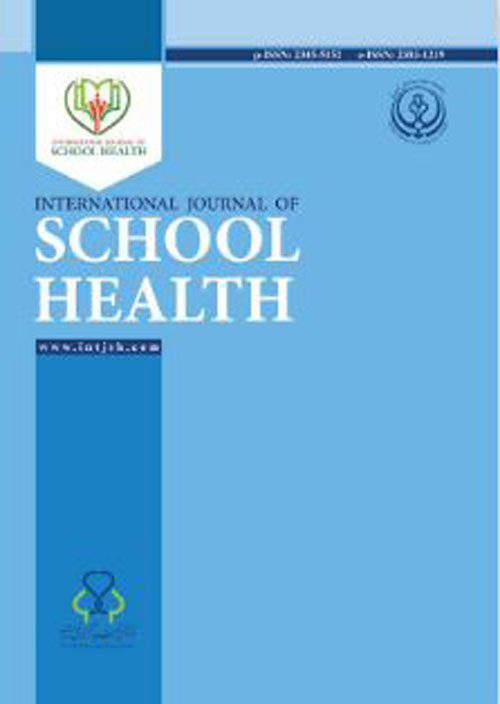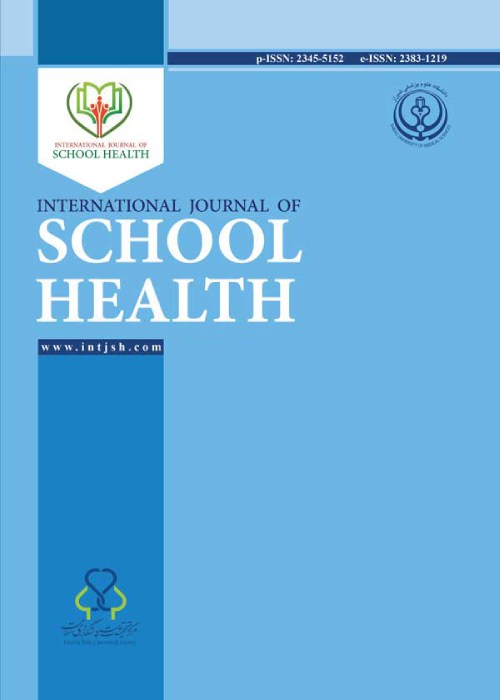فهرست مطالب

International Journal of School Health
Volume:8 Issue: 1, Winter 2021
- تاریخ انتشار: 1399/12/25
- تعداد عناوین: 8
-
-
Pages 3-13Context
Foodborne disease is one of the leading causes of early childhood death and childhood diarrhea worldwide. Providing food safety education is believed to be of necessity to prevent foodborne diseases among school-aged students; however, limited studies have addressed food safety education worldwide, particularly for elementary school students. Hence, we conducted this comprehensive review to examine the availability and impact of food safety education for elementary school students worldwide and identify areas that are still needed for future research.
Evidence AcquisitionOur inclusion criteria comprised all the studies on elementary school students (aged 5-12) and food safety components that have been published in English between 2010 and 2020, without geographic restriction. In this review project, we utilized nine major data sources, including PubMed, Science Direct, MEDLINE, and CINAHL.
ResultsFood safety guidelines and educational resources have been established worldwide; however, limited food safety education has been targeted to elementary school students, particularly in developing countries. There is a lack of additional findings concerning food safety behaviors among elementary school students, and insufficient food safety training for teachers.
ConclusionThere is an urgent need to provide effective food safety education to elementary school students, which specifically focuses on improving their behaviors. Furthermore, sufficient food safety training and professional development needs to be provided for school teachers.
Keywords: Food hygiene, Foodborne diseases, Elementary school students, Primary school students, School-aged students -
Pages 14-22Background
Subjective well-being is considered as one of the most important indicators of adolescents’ health. The present study aimed to investigate the mediating role of self-efficacy beliefs in the causal relationships of peer support and parent-child interaction with the subjective well-being of students with hearing impairment in Kermanshah city in 2019.
MethodsThe study was a descriptive correlation performed employing path analysis. The statistical population comprised 268 girl students with hearing impairment in Kermanshah city, 146 of which were selected as the sample using stratified random sampling. In the present research, we utilized Ryff ’s Psychological Well-Being Scales, the Peer Support Questionnaire, Child-Parent Relationship Scale, and Self-Efficacy Beliefs Questionnaire.
ResultsThe mean±SD of subjective well-being, peer support, parent-child interaction, and self-efficacy beliefs were respectively 53.10±23.86, 47.72±13.51, 101.20±23.78, and 43.20±12.96. A direct and positive association was observed between peer support and subjective well-being (β=0.167, P=0.0001), peer support and self-efficacy beliefs (β=0.398, P=0.0001), parent-child interaction and self-efficacy beliefs (β=0.544, P=0.0001), and between self-efficacy beliefs and subjective well-being (β=0.429, P=0.0001). The results of path analysis indicated that self-efficacy beliefs played a mediating role in the association between peer support (β=0.177, P=0.0001) and parent-child interaction (β=0.193, P=0.0001) with subjective well-being.
ConclusionAccording to our results, the proposed model was of good efficiency. Accordingly, by strengthening and improving peer support relationships, parent-child interaction and self-efficacy beliefs can improve the subjective well-being of deaf adolescents.
Keywords: Hearing Loss, Health, Parent-child relations, Self-efficacy, culture, Students -
Pages 23-30Background
Schools have an important role to play in helping students achieve buoyancy (AB) and healthy learning. The main purpose of this study is to predict students’ academic buoyancy based on the health literacy (HL) of school health nurses (SHN) and their performance in health promoting high schools.
MethodsThis descriptive correlational study consisted of the SHN of all health promotion secondary schools of East Azarbaijan province educational districts. The statistical population of the study includes 260 SHN in schools in the 2019-2020 academic year. For sampling, 160 SHN and 320 students were selected using stratified random sampling. For data collection, we used the HL Questionnaire of the Institute of Health Sciences, the SHN Performance Questionnaire of Vaparzeh and colleagues and the AB Questionnaire of Hosseinchari and Dehghanizadeh.
ResultsEstimation of the descriptive statistics and the correlation of variables based on SPSS software showed that the means of HL (141.41±18.49), performance (95.45±12.89), and AB (52.3±6.81) were higher than average. There was a significant correlation between HL, performance, and AB. The results of structural equation modeling with PLS software demonstrated that the performance of SHN and its dimensions could be predicted based on HL (p <0.001), But students’ AB is not predictable based on HL (P=0.054) and the performance of SHNs (P=0.63) or mediated by their performance (P=0.09).
ConclusionHealth literacy promotion programs for teachers and school nurses can ensure the success of schools in improving student health.
Keywords: Health Literacy, Health promotion, Delivery of health care, Schools, Academic buoyancy -
Pages 31-40Background
Following up children’s health at schools is crucial to ensuring their health and nutrition supply. Cambodia does not have a system for assessing the children’s growth. In this regard, WHO child growth reference might be used to assess child growth in this country. The present study aimed to compare Cambodian primary schoolchildren’s growth in three categories and assess their growth status by reference to the South-East Asian Nutrition Survey (SEANUTS) and WHO references.
MethodsThis is a case study of primary school children’s growth in Cambodia. Aichi University of Education in Japan conducted physical measurement in some primary schools in Cambodia in three categories: an urban school, a rural school with “school meals”, and a rural school without “school meals”. A total sample size of 9 487 primary schoolchildren was measured from 2015 to 2020. The data were analyzed by a computed formulation of LMS and SPSS statistics version 20.
ResultsCambodian primary schoolchildren in the urban school were taller and heavier than those in the rural school with “school meals” and the rural school without “school meals”. The children in the rural school without “school meals” were the shortest and the lightest. The physical growth of the “schoolchildren” in Cambodia was similar to those of the pooled SEANUTS, but far below the WHO references.
ConclusionSchool meals have a positive influence on children’s growth. SEANUTS growth reference might be fitted to assess child growth in Cambodia, but the WHO reference is not fitted. National child growth curve and reference should be devised to accurately assess children’s growth in Cambodia.
Keywords: Cambodia, Schools, Child, growth, Height-for-age, Weight-for-age, Child growth reference, LMS -
Pages 41-46Background
Oral diseases remain one of the major public health challenges in India. Mobile dental services may be used as alternatives to supplement the standard care in order to reach underserved populations in several countries. However, not enough research has been conducted on school children. Hence, this paper aimed to evaluate the cost-effectiveness (where cost is expressed in monetary units and results in non-monetary units) of a mobile dental vehicle (MDV) in delivering primary oral health care among adopted schools of a dental college in Bengaluru.
MethodsThis retrospective population-based study was conducted among adopted children of the age group of 4–15 years in Bengaluru. The data were collected from the college camp out-patient register over three academic years of 2017-18, 2018-19, and 2019-20 in December 2020. Cost-effectiveness was calculated utilizing the formula total cost (direct+indirect) of service provision with the total number of the patients who used the services in the same period. Statistical tests unpaired student t-test, ANOVA, Tukey’s post hoc test, and all the statistical tests were set with a level of significance (p <0.1), which was conducted using the statistical package SPSS version 19.0.
ResultsA total of 14,806 patients and 75,421 teeth were treated in mobile dental vehicle. The cost for each patient was around 259.0/- rupees and for each tooth, around 51.3/-rupees. Around 2686 teeth were benefitted from the use of a portable dental chair. Therefore, the cost of treating each tooth was around 12.3/- rupees. The mean difference in the number of the treated patients was found to be significantly decreasing.
ConclusionWe conducted the current study to demonstrate the costs of providing primary oral health care among adopted schools. Mobile dental vehicle and the portable dental chair were found to be cost-effective in delivering primary oral health care.
Keywords: Cost-effectiveness, Schools, Children, Mobile dental vehicle, Portable dental chair -
Pages 47-54Background
One of the most important issues in school health is believed to be finding factors that could affect students’ participation in physical activity and sports. Thus, we conducted the present study to investigate the effects of peers on motivation and physical activity behavior of students. This study was theoretically based on the self-determination theory and transcontextual model.
MethodsThe present research was a correlational survey based on structural equations. The statistical sample included 384 male and female high school students from Azadshahr, Golestan, Iran, in 2019. Standard questionnaires including Peers Questionnaire, Relatedness Need Satisfaction Questionnaire, Intrinsic Motivation Scale, and Physical Activity Behavior Questionnaire were used for collecting the data. We utilized structural equations method to analyze the data.
ResultsThe results revealed a significant effect of peers on relatedness need satisfaction (β=0.65, T=21.17). Moreover, relatedness need satisfaction had a significant effect on students’ intrinsic motivation in the physical education class (β=0.76, T=43.78). Furthermore, intrinsic motivation in the physical education class was found to be significantly transferred to intrinsic motivation outside school (β=0.73, T=42.44). Finally, intrinsic motivation in leisure time significantly affected students’ physical activity (β=0.80, T=51.48).
ConclusionsThese findings highlighted the positive role of peers in physical education class in promoting the students’ motivation and physical activity behavior in leisure time.
Keywords: Peers, Motivation, Physical activity, Physical education, School -
Pages 55-61Background
One of the main challenges for parents during puberty is to tackle emotional problems in their teenagers, which may threaten their current and future health and affect the quality of parent-child relationships. Integrated parental self-awareness was assessed on the emotional regulation patterns of adolescents aged 13 to 15 years. This study was conducted to investigate the predictive role of parental awareness and self-awareness in emotion regulation patterns of 13 to 15 year olds.
MethodsThe research design was descriptive-correlational. The statistical population was 13 to 15-year-old adolescents of Parsian city and their mothers, 140 of whom were selected using appropriate random sampling method in years 2019-2020. The data were collected utilizing the Emotional Regulation Questionnaire (ERQ), the Mind/Conscious Mind Scale (MMS) and the Integrated Self-Knowledge Scale (ISK). Pearson correlation coefficient and stepwise regression were employed to analyze the data.
ResultsThe obtained results revealed a significant inverse relationship between integrated self-cognition and cognitive repression (P<0.002, r=0.46) and mindfulness with cognitive repression (P≤0.004, r=-0.32). There was a direct and significant relationship between knowledge with cognitive reassessment assessment (P≤0.001, r=0.45) and integrated self-knowledge with cognitive reassessment (P≤0.004, r=0.37) at a confidence level of 0.95. Moreover, the results of linear regression to predict emotion regulation patterns in adolescents showed that the coherent variable of self-awareness with a coefficient of explanation of 0.43 and the variable of consciousness with a coefficient of explanation of 0.35 could predict cognitive emotion.
ConclusionsParents, family, and child counselors could make use of parental awareness and self-knowledge education and increase the mental health components of mothers as a way to prevent and reduce adolescents’ emotional problems.
Keywords: Emotion regulation, Mindfulness, Integrative self-knowledge


